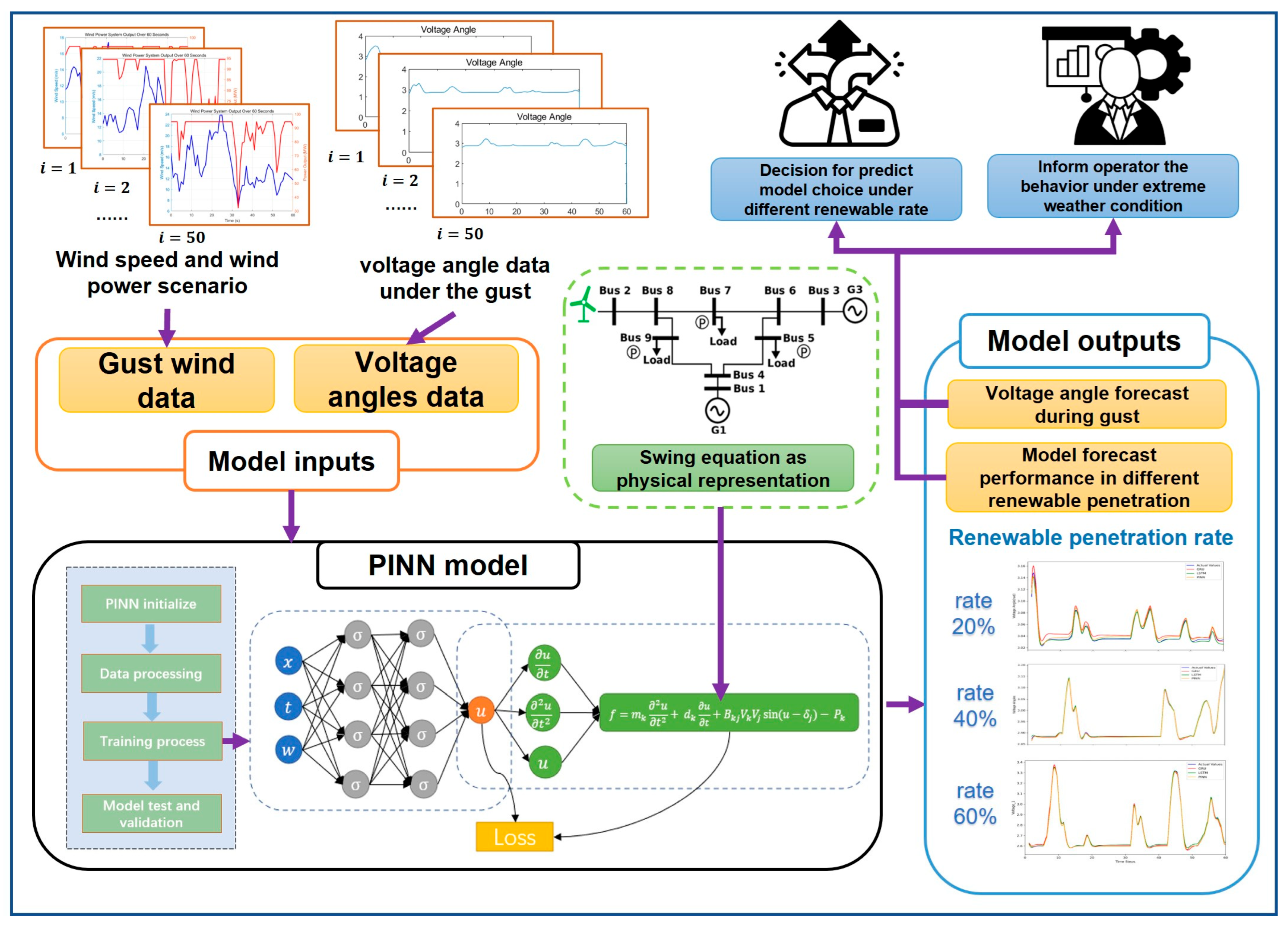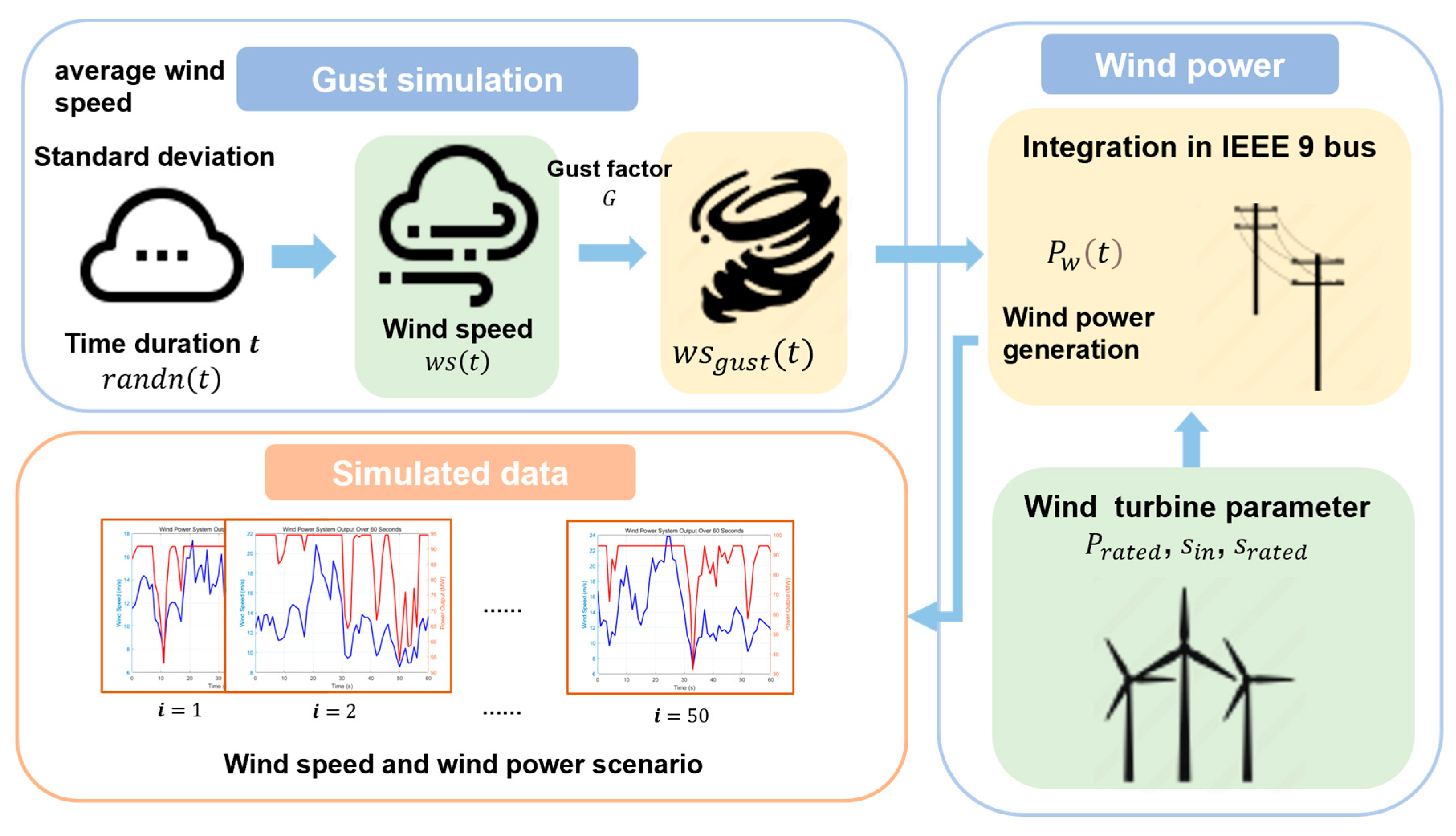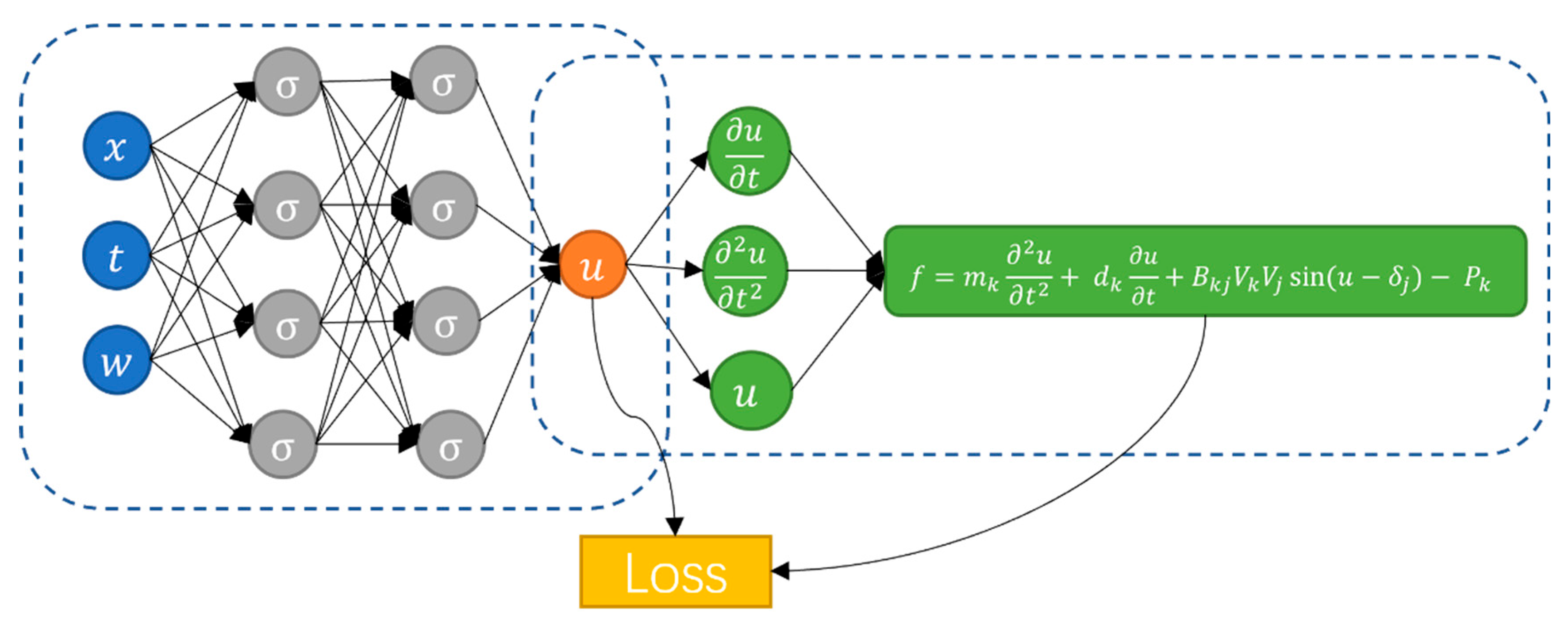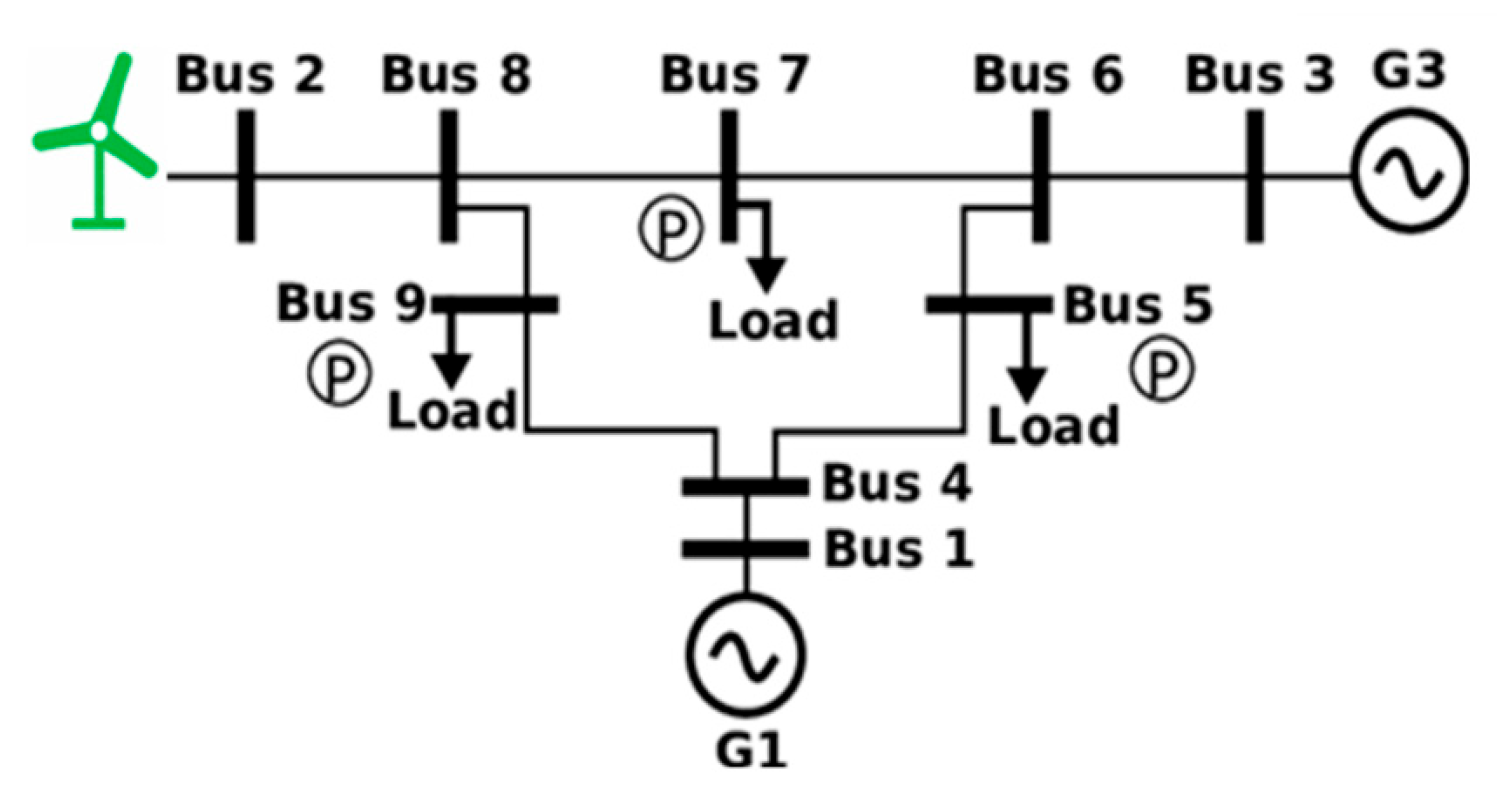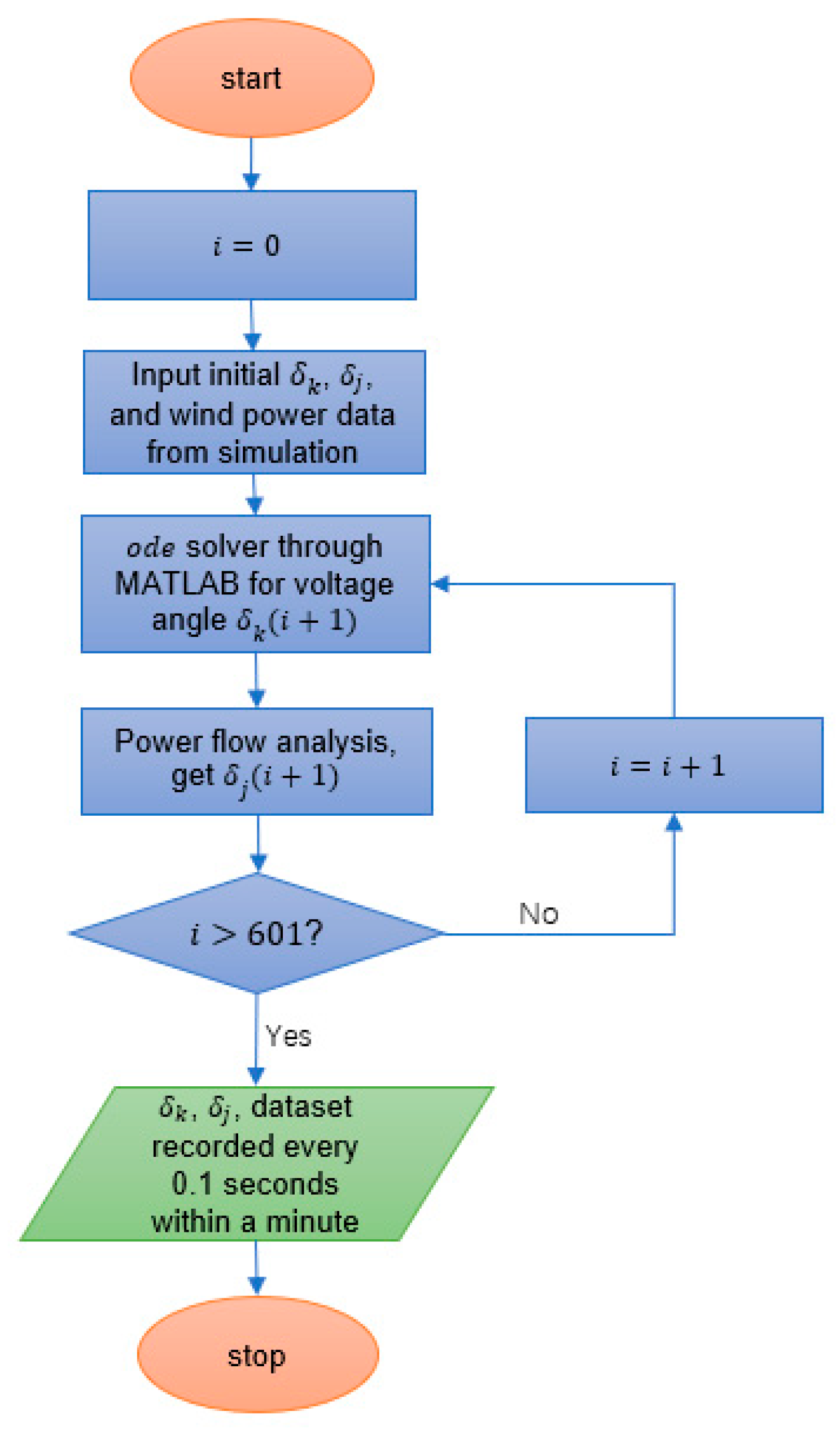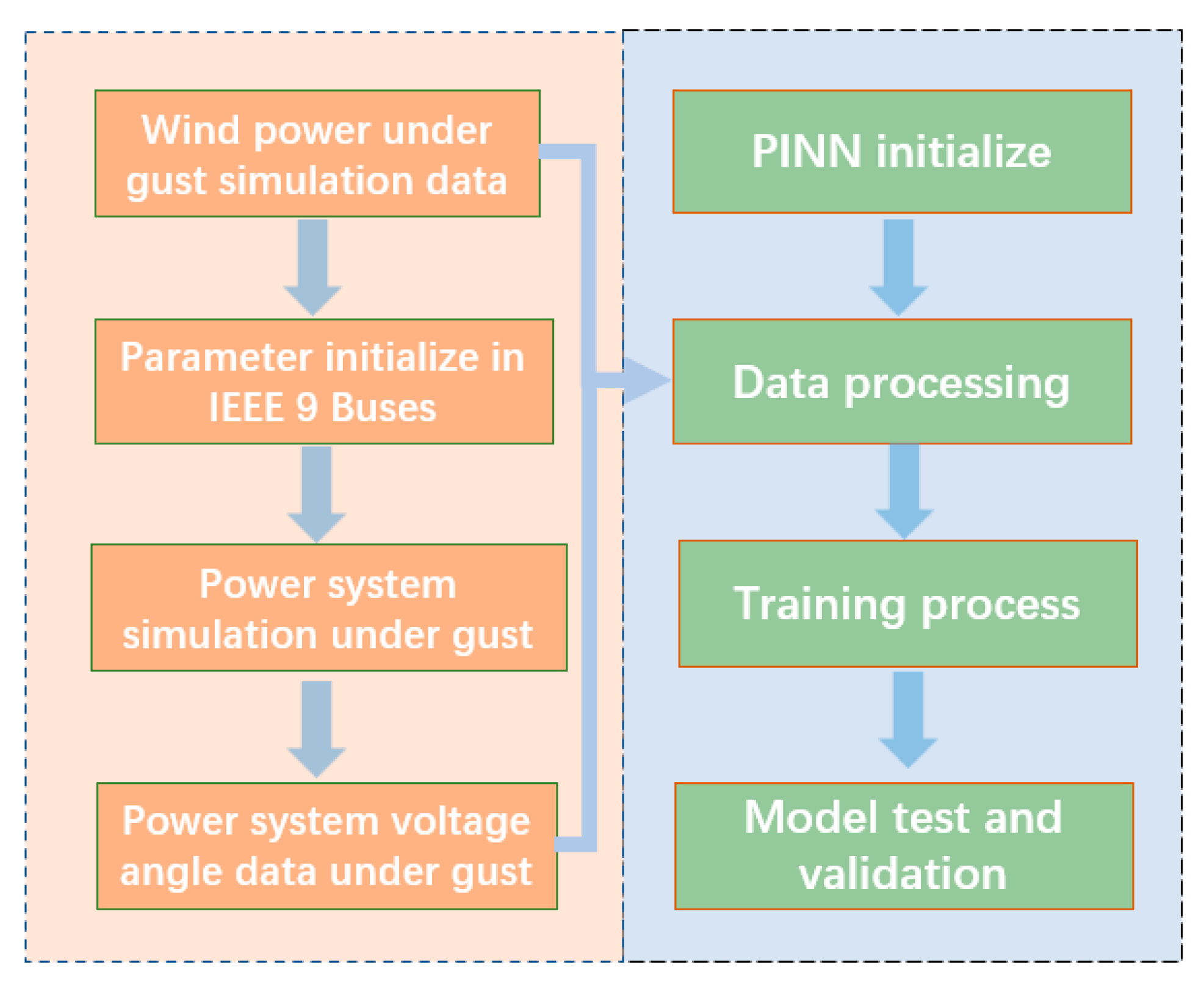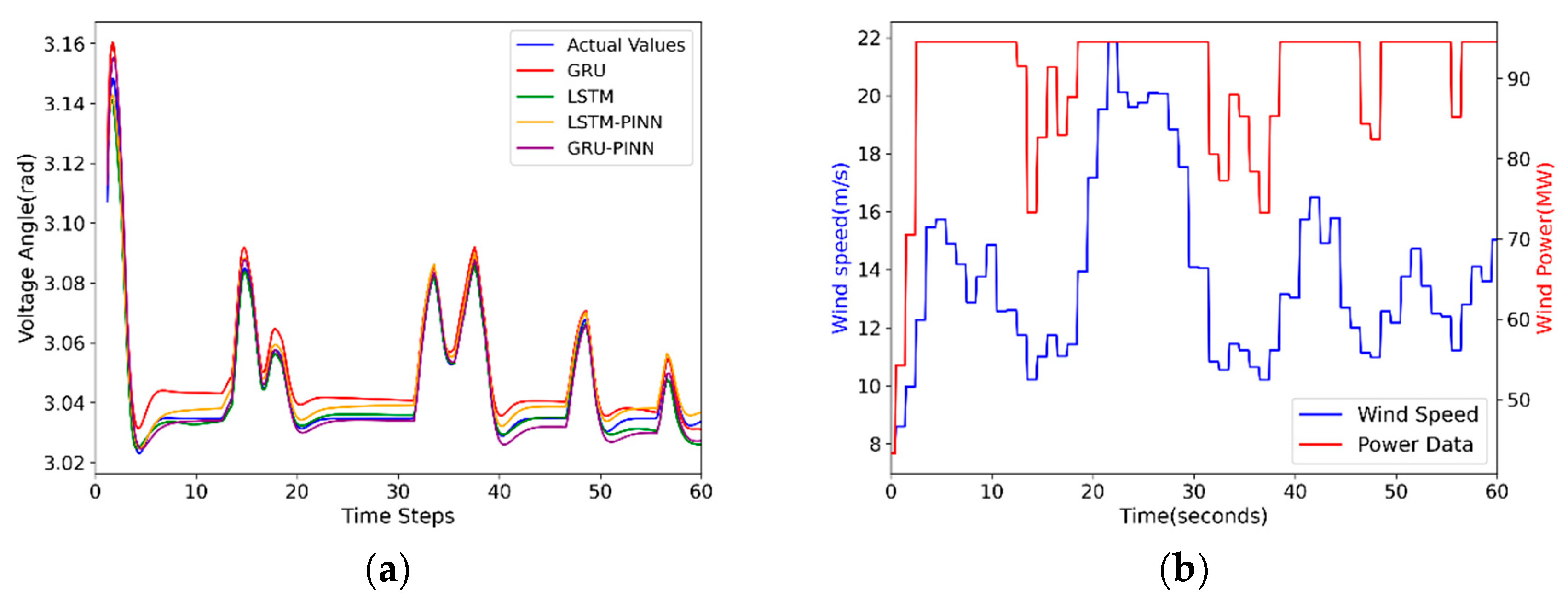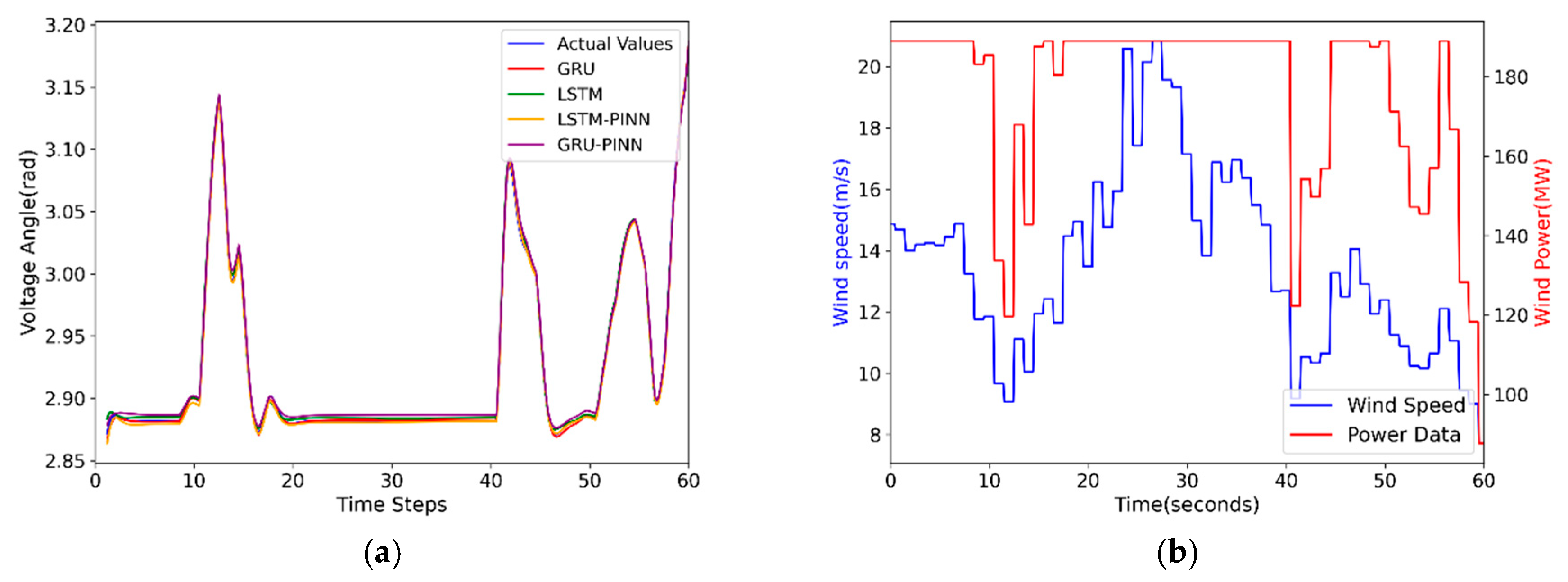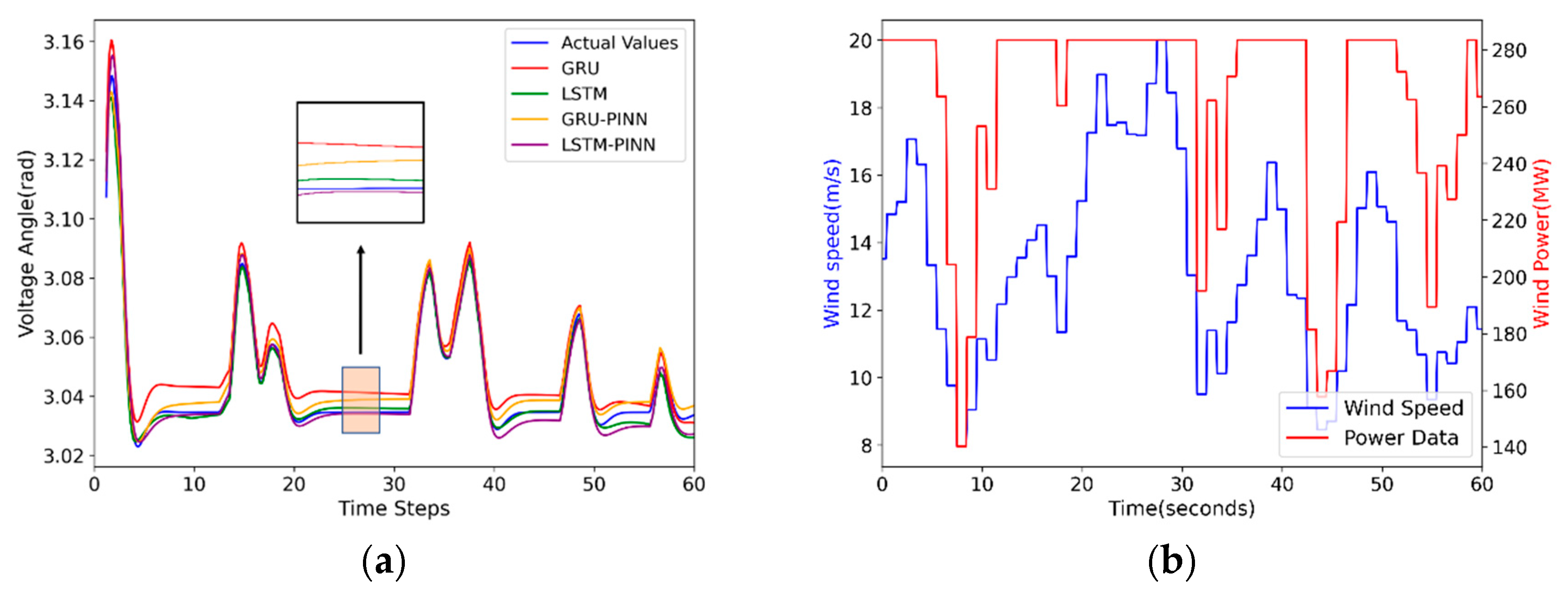Author Contributions
Conceptualization, R.Y. and L.V.; methodology, R.Y.; software, R.Y.; validation, R.Y. and L.V.; formal analysis, R.Y.; investigation, R.Y.; resources, R.Y.; data curation, R.Y.; writing—original draft preparation, R.Y.; writing—review and editing, L.V.; visualization, R.Y.; supervision, L.V.; project administration, L.V. All authors have read and agreed to the published version of the manuscript.
Figure 1.
Overview of the proposed PINN-based framework for forecasting voltage angles under gusty wind conditions across different renewable penetration rates. The model integrates wind and voltage angle data using the swing equation (green dashed box) to improve prediction accuracy and support operator decision making under extreme weather scenarios. Arrows indicate the data flow and model inference path from inputs to outputs.
Figure 1.
Overview of the proposed PINN-based framework for forecasting voltage angles under gusty wind conditions across different renewable penetration rates. The model integrates wind and voltage angle data using the swing equation (green dashed box) to improve prediction accuracy and support operator decision making under extreme weather scenarios. Arrows indicate the data flow and model inference path from inputs to outputs.
Figure 2.
Swing equation representation between Bus k and Bus j.
Figure 2.
Swing equation representation between Bus k and Bus j.
Figure 3.
Process of gust simulation and wind power integration into the IEEE 9-bus system. Wind speed scenarios were generated using randomized gust factors and wind turbine parameters, then converted to wind power, and incorporated into the grid model to produce simulated wind speed and power profiles.
Figure 3.
Process of gust simulation and wind power integration into the IEEE 9-bus system. Wind speed scenarios were generated using randomized gust factors and wind turbine parameters, then converted to wind power, and incorporated into the grid model to produce simulated wind speed and power profiles.
Figure 4.
The structure of physics-informed learning. The left dashed box represents the neural network that takes input variables and predicts the target variable. The right dashed box shows the swing equation, used as the physics-based constraint. Arrows indicate the flow of information from input to prediction, and through the loss function where the discrepancy between model outputs and physical laws is minimized.
Figure 4.
The structure of physics-informed learning. The left dashed box represents the neural network that takes input variables and predicts the target variable. The right dashed box shows the swing equation, used as the physics-based constraint. Arrows indicate the flow of information from input to prediction, and through the loss function where the discrepancy between model outputs and physical laws is minimized.
Figure 5.
IEEE 9-bus system consisting of buses labeled Bus 1 to Bus 9, three generators (G1, G3, and a wind turbine connected at Bus 2), and loads connected at Bus 5, Bus 7, and Bus 9.
Figure 5.
IEEE 9-bus system consisting of buses labeled Bus 1 to Bus 9, three generators (G1, G3, and a wind turbine connected at Bus 2), and loads connected at Bus 5, Bus 7, and Bus 9.
Figure 6.
Flowchart illustrating the procedure for calculating dynamic voltage angles using wind power input.
Figure 6.
Flowchart illustrating the procedure for calculating dynamic voltage angles using wind power input.
Figure 7.
Time-series plots of wind power generation (bottom) and the corresponding voltage angle response at Bus 1 (top). The results illustrate how fluctuations in wind power over 60 s influence the dynamic behavior of voltage angles in the system.
Figure 7.
Time-series plots of wind power generation (bottom) and the corresponding voltage angle response at Bus 1 (top). The results illustrate how fluctuations in wind power over 60 s influence the dynamic behavior of voltage angles in the system.
Figure 8.
Overall flowchart illustrating the process of physics-informed learning for voltage angle prediction. The framework combines gust-induced wind power simulations and power system modeling with the PINN workflow, including initialization, data processing, training, and validation.
Figure 8.
Overall flowchart illustrating the process of physics-informed learning for voltage angle prediction. The framework combines gust-induced wind power simulations and power system modeling with the PINN workflow, including initialization, data processing, training, and validation.
Figure 9.
(a) Comparison of predicted voltage angles using GRU, LSTM, GRU-PINN, and LSTM-PINN against actual values under Scenario 1. (b) The corresponding wind speed and wind power profile used as input for the voltage angle prediction.
Figure 9.
(a) Comparison of predicted voltage angles using GRU, LSTM, GRU-PINN, and LSTM-PINN against actual values under Scenario 1. (b) The corresponding wind speed and wind power profile used as input for the voltage angle prediction.
Figure 10.
(a) Voltage angle predictions using GRU, LSTM, GRU-PINN, and PINN-PINN models compared to actual values under Scenario 2. (b) Corresponding wind speed and wind power profiles used as inputs, reflecting more dynamic wind behavior and higher renewable penetration.
Figure 10.
(a) Voltage angle predictions using GRU, LSTM, GRU-PINN, and PINN-PINN models compared to actual values under Scenario 2. (b) Corresponding wind speed and wind power profiles used as inputs, reflecting more dynamic wind behavior and higher renewable penetration.
Figure 11.
(a) Voltage angle prediction results of different models under Scenario 3, showing that LSTM-PINN and GRU-PINN closely follow actual values under highly variable wind conditions. (b) Corresponding wind speed and wind power profile used as input, representing the highest renewable penetration level in the study.
Figure 11.
(a) Voltage angle prediction results of different models under Scenario 3, showing that LSTM-PINN and GRU-PINN closely follow actual values under highly variable wind conditions. (b) Corresponding wind speed and wind power profile used as input, representing the highest renewable penetration level in the study.
Table 1.
Parameters used in the wind power simulation, including renewable penetration levels, turbine characteristics, load demand, and gust event configuration.
Table 1.
Parameters used in the wind power simulation, including renewable penetration levels, turbine characteristics, load demand, and gust event configuration.
| Parameter | Value | Unit |
|---|
| Penetration | 20%, 40%, 60% | / |
| Rated power | 94.5, 189, 283.5 | MW |
| Load demand | 315 | MW |
| Cut-in speed | 4 | m/s |
| Cut-out speed | 25 | m/s |
| Rated speed | 12 | m/s |
| Gust amplification factor | 1.5 | / |
| t | [0, 60] | seconds |
Table 2.
Parameters used in the power system simulation, including generator dynamics, admittance, voltage levels, time settings, and initial conditions for rotor angles and speeds.
Table 2.
Parameters used in the power system simulation, including generator dynamics, admittance, voltage levels, time settings, and initial conditions for rotor angles and speeds.
| Parameter | Value | Unit |
|---|
| 0.4 | seconds |
| 1 | p.u./s |
| 1.63 | Siemens |
| 1 | p.u. |
| 1 | p.u. |
| [0, 60] | seconds |
| 0.1 | seconds |
| 2.8 | rad |
| 0 | rad/s |
| −10.16 | rad |
Table 3.
Performance comparison of standard LSTM, standard GRU, GRU-PINN, and LSTM-PINN in Scenario 1.
Table 3.
Performance comparison of standard LSTM, standard GRU, GRU-PINN, and LSTM-PINN in Scenario 1.
| Method | MSE | R-Squared |
|---|
| GRU | 9.5 × 10−5 | 0.972 |
| LSTM | 7.5 × 10−5 | 0.981 |
| GRU-PINN | 8.5 × 10−5 | 0.978 |
| LSTM-PINN | 8.2 × 10−5 | 0.980 |
Table 4.
Performance comparison of standard LSTM, standard GRU, GRU-PINN, and LSTM-PINN in Scenario 2.
Table 4.
Performance comparison of standard LSTM, standard GRU, GRU-PINN, and LSTM-PINN in Scenario 2.
| Method | MSE | R-Squared |
|---|
| GRU | 1.2 × 10−4 | 0.960 |
| LSTM | 8.8 × 10−5 | 0.975 |
| GRU-PINN | 5.8 × 10−5 | 0.983 |
| LSTM-PINN | 5.4 × 10−5 | 0.987 |
Table 5.
Performance comparison of standard LSTM, standard GRU, GRU-PINN, and LSTM-PINN in Scenario 3.
Table 5.
Performance comparison of standard LSTM, standard GRU, GRU-PINN, and LSTM-PINN in Scenario 3.
| Method | MSE | R-Squared |
|---|
| GRU | 1.4 × 10−4 | 0.955 |
| LSTM | 1.3 × 10−4 | 0.968 |
| GRU-PINN | 5.9 × 10−5 | 0.987 |
| LSTM-PINN | 4.1 × 10−5 | 0.991 |
